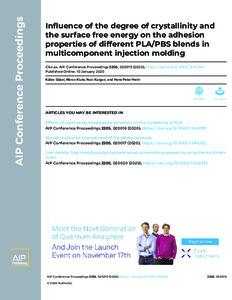| dc.date.accessioned | 2020-12-04T16:13:21Z | |
| dc.date.available | 2020-12-04T16:13:21Z | |
| dc.date.issued | 2020-01-10 | |
| dc.identifier | doi:10.17170/kobra-202012012320 | |
| dc.identifier.uri | http://hdl.handle.net/123456789/12095 | |
| dc.description | This article may be downloaded for personal use only. Any other use requires prior permission of the author and AIP Publishing. This article appeared in AIP Conference Proceedings 2205, 020019 (2020) and may be found at https://doi.org/10.1063/1.5142934. | eng |
| dc.language.iso | eng | eng |
| dc.rights | Urheberrechtlich geschützt | |
| dc.rights.uri | https://rightsstatements.org/page/InC/1.0/ | |
| dc.subject | environmental impacts | eng |
| dc.subject | mechanical instruments | eng |
| dc.subject | interfacial tension | eng |
| dc.subject | surface energy | eng |
| dc.subject | material properties | eng |
| dc.subject | material synthesis and processing | eng |
| dc.subject | crystal structure | eng |
| dc.subject | adhesive bonding | eng |
| dc.subject | polymers | eng |
| dc.subject.ddc | 600 | |
| dc.title | Influence of the degree of crystallinity and the surface free energy on the adhesion properties of different PLA/PBS blends in multicomponent injection molding | eng |
| dc.type | Aufsatz | |
| dcterms.abstract | Biocomposites made of biodegradable polymers have grown in interest due to their environmentally friendliness, considering that non-biodegradable polymers waste conduces to pollution, displaying high environmental impact in climatic changes. Therefore, in the presented study, biodegradable Poly (lactic acid) (PLA) and poly (butylene succinate) (PBS) were investigated as a series of PLA/PBS melt-blending compounds with the weight ratios of 50/50, 60/40, 70/30, 80/20 and 90/10. In a two-component injection molding process, they were used as the hard component to create hard-soft- combinations. Thermal properties, crystallinity and mechanical properties were examined with regard to the change in the adhesive bonding strength between the PLA/PBS compounds and thermoplastic polyurethane (TPU) under the influence of time and temperature (storage at room temperature and 100 °C in the course of 1, 3, 7 and 14 day(s)). The adhesion properties of the PLA/PBS blends were identified via Drop Shape Analysis (DSA) using a contact angle measurement device and corroborated with FTIR/ATR measurements. The attenuation in the interfacial tension between the blends and TPU with increasing amount of PBS content in the blend provided better bonding abilities. The maximal load required to disconnect these two components was measured by a universal tensile test machine. According to the results, the highest maximal load (552,69 N) was achieved with the PLA/PBS blend with a weight ratio of 60/40 wt% after being subjected to seven days of storage at 100 °C. | eng |
| dcterms.accessRights | open access | |
| dcterms.creator | Güzel, Kübra | |
| dcterms.creator | Klute, Marco | |
| dcterms.creator | Kurgan, Naci | |
| dcterms.creator | Heim, Hans-Peter | |
| dc.relation.doi | doi:10.1063/1.5142934 | |
| dc.subject.swd | Umweltbelastung | ger |
| dc.subject.swd | Grenzflächenspannung | ger |
| dc.subject.swd | Oberflächenspannung | ger |
| dc.subject.swd | Stoffeigenschaft | ger |
| dc.subject.swd | Materialbearbeitung | ger |
| dc.subject.swd | Kristallstruktur | ger |
| dc.subject.swd | Biologisch abbaubarer Kunststoff | ger |
| dc.type.version | publishedVersion | |
| dcterms.source.identifier | eissn:1551-7616 | |
| dcterms.source.issue | Issue 1 | |
| dcterms.source.journal | AIP Conference Proceedings | eng |
| dcterms.source.pageinfo | 020019-1 - 020019-5 | |
| dcterms.source.volume | Volume 2205 | |
| kup.iskup | false | |

